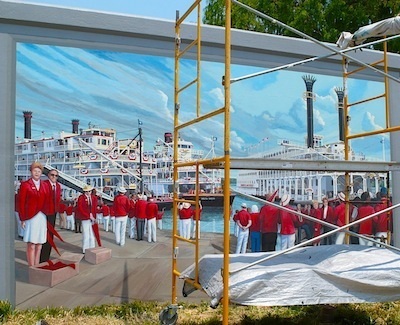Shore Excursion: Paducah, Kentucky, floodwall highlights local history
Walking ashore at Paducah, Kentucky, I saw a bittersweet image.
There on the floodwall is a beautiful painting of the three sister riverboats – the Delta Queen, the Mississippi Queen and the American Queen.
The mural depicts an actual event. On a historic July day in 1996, all three of the mighty steamboats docked at Paducah at the same time. The painting commemorates that gathering as local townsfolks welcome the queens and passengers.
As a many-times cruiser on all three boats, the painting brings back memories. Bitter memories because two of the queens are no longer cruising. The Mississippi Queen was torn apart in 2011 and sold for salvage. The Delta Queen is permanently docked in Chattanooga as a floating hotel. And the American Queen was pulled from the rivers in 2008.
Sweet memories because the American Queen was bought by a new company and began cruising again in April 2012. The beloved passenger boat now makes regular stops again in Paducah – a glorious sight for riverfolks and local people.
“We are delighted to see the American Queen back in Paducah,” says resident Betty McManus. “We have really missed all three of the boats.”
In fact, some shops in the little towns along the rivers went out of business after the boats stopped cruising four years ago. For the first time since 1811, there were no overnight steamships on America’s rivers.
“It does help our economy when the boats bring passengers here,” McManus notes.
Founded in 1815, Paducah was named for Chickasaw Indian Chief Paduke, known for his kindness and generosity to those traveling down the river by keelboat and flatboat. The famous floodwall is a work of art but the wall is actually the result of a disaster.
In 1937, the Ohio River at Paducah quickly rose above its 50-foot flood stage, cresting at 60.8 feet on Feb. 2. With 18 inches of rainfall in 16 days, along with sheets of swiftly moving ice, the ’37 flood was the worst natural disaster in Paducah’s history.
For nearly three weeks, the town’s 27,000 residents were forced to flee to stay with friends and relatives in higher ground. Buildings in downtown Paducah still bear plaques that show the high water marks.
Because Paducah’s earthen levee was ineffective against the ’37 flood, the United States Army Corps of Engineers was commissioned to build the floodwall that now protects the city from the ravages of flooding.
“Then we decided to paint the wall to make it look better,” McManus says. “Now we have almost 50 murals that show the history of Paducah.”
Started in 1996 by mural artist Robert Dafford and his team, the scenes on three city blocks of the floodwall were created over the next 10 years. One final panel was added in 2010 to honor the 100-year anniversary of the local Boy Scout troop.
“The paintings are touched up each year,” McManus says, explaining why scaffolding blocks the three Queens mural that I was trying to photograph.
Each mural panel has its own spotlight and an interpretive plaque with a short history lesson on the scene depicted in the panel.
Along with the three Queens panel, one of my favorites is a 1938 scene when the Ohio River froze solidly completely across. The huge freeze brought barge traffic to a halt. It also provided a winter playground for Paducah residents and schoolchildren freed from school by the freezing weather. Look closely and see a black dog scampering over the ice. Reminds me of my own Pepper at home.
Story and photo by Jackie Sheckler Finch















View Recent Comments